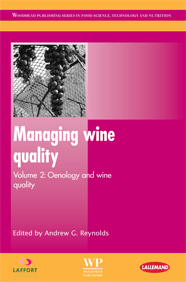Managing Wine Quality, volume 2, edited by Andrew G. Reynolds
| Title of book: | Managing Wine Quality: Volume 2 – oenology and wine quality |
| Author: | Ed. Andrew G. Reynolds |
| Publisher: | Woodhead Publishing |
| Publication date: | September 2010 |
| ISBN | 978 1 84569 798 3 |
| Pages: | 651 |
| Price: | £160.00 |
 Read here for a review of volume 1.
Read here for a review of volume 1.
Volume 2 of this erudite tale moves on to issues of winemaking and their effects on wine quality and style. Further chapters are commissioned from specialists around the world, and a few major yeast, (and other winemaking products) manufacturers also share their expertise.
Yeasts, oenologically good and bad, as well as research into genetically engineered yeasts, plus bacteria and enzymes are order of the day for this volume, both in respect of fermentation and maturation (sur lies).
Closures and various taints follow closely. Then icewines and sparkling wines each have dedicated chapters. Fortified wines are possibly an opportunity not to be missed in an ensuing edition.
Chapters review the current state of knowledge and practice, as well as targeting specific themes for greater detail. The chapter on enzymes kicks off with definitions and production methods, before outlining the regulatory framework for their use. Methods of use and applications in winemaking are detailed, from the release of aroma compounds, to microbial stability, to increasing must yield and aiding clarification.
Given its trendy status, micro-oxygenation is explored in a combined chapter with oak alternatives and added tannins. As micro-oxygenation, with oak alternatives or with added tannins, is suggested as a (cheaper) alternative to barrel ageing, this arrangement makes good sense. The paucity of strong scientific study regarding some of the benefit claims of micro-oxygenation is stated. Despite the technique being in usage since its invention in the 1990s, it seems the first peer-reviewed scientific report was only in 2006.
The chapter on sparkling wine focuses on issues unique to bubblies, notably the foam, or the mousse. High quality results in a foam that creates a crown of relatively stable bubbles around the top of the liquid. This sort of foam is not found in liquids where the carbon dioxide is retained under pressure only. Good quality foaming bubbles need tensoactive compounds such as modest alcohol and glycerol to do their thing. And we’re told 12% is the critical level of alcohol, above which wines are less bubbly. It’s probably no surprise that Champagne comes in at 12% abv.
These volumes state they are targeted at undergraduate and graduate level wine science courses. They seem adroitly suited to this audience.



